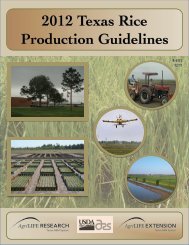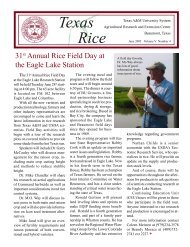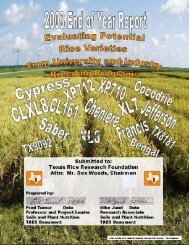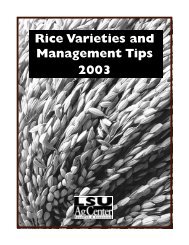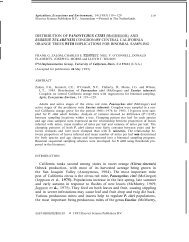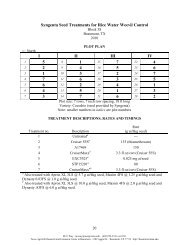2007 - Texas A&M AgriLIFE Research Center at Beaumont - Texas ...
2007 - Texas A&M AgriLIFE Research Center at Beaumont - Texas ...
2007 - Texas A&M AgriLIFE Research Center at Beaumont - Texas ...
You also want an ePaper? Increase the reach of your titles
YUMPU automatically turns print PDFs into web optimized ePapers that Google loves.
Apply the remaining nitrogen in the floodw<strong>at</strong>er <strong>at</strong> panicle<br />
differenti<strong>at</strong>ion or earlier if plants become nitrogen deficient.<br />
Weed control<br />
Although continuous flood and pinpoint flood culture<br />
should suppress red rice and other weeds, they do not provide<br />
adequ<strong>at</strong>e control. These steps help control weeds:<br />
• Apply Bolero ® 8EC preplant <strong>at</strong> 4 pints per acre to suppress<br />
red rice and control certain other weeds. Apply it<br />
immedi<strong>at</strong>ely after soil prepar<strong>at</strong>ion and flood the field<br />
within 3 days. Do not seed the field any sooner than 24<br />
hours after the field has been brought to flood level.<br />
• Apply Ordram ® 8E preplant <strong>at</strong> 3 to 4 pints per acre depending<br />
on soil texture. Use ground applic<strong>at</strong>ion equipment<br />
only, incorpor<strong>at</strong>e immedi<strong>at</strong>ely and flood as soon<br />
as possible. You can also use Ordram ® 15G preplant<br />
incorpor<strong>at</strong>ed <strong>at</strong> 20 pounds per acre. Mechanically<br />
incorpor<strong>at</strong>e within 6 hours of applic<strong>at</strong>ion and flood as<br />
soon as possible.<br />
• In addition, you can apply Grandstand ® <strong>at</strong> 0.67 to 1<br />
pint per acre to control certain broadleaf weeds. Using<br />
Permit ® , Basagran ® or Londax ® alone or with propanil<br />
also can control certain aqu<strong>at</strong>ic weeds. R<strong>at</strong>es depend<br />
on growth stage.<br />
Planting<br />
The flooded conditions mand<strong>at</strong>e th<strong>at</strong> the field be aerial<br />
seeded. Timing and management is critical. The field must<br />
be seeded as soon after flood establishment and stabiliz<strong>at</strong>ion<br />
to minimize damage from seed midge. Also, the w<strong>at</strong>er<br />
oxygen content will decrease after flood establishment. The<br />
sprouted seed should be ready for planting as soon as the<br />
field is flooded. The seeding r<strong>at</strong>e should be increased to 120<br />
to 140 pounds per acre.<br />
Blackbirds<br />
M. O. Way<br />
Blackbirds, primarily red-winged blackbirds, are pests of<br />
rice during the planting season, the seedling stage and the ripening<br />
period. The birds consume seed and seedlings on and<br />
under the soil, which can result in inadequ<strong>at</strong>e plant stands.<br />
In some cases, the fields must be replanted. Reseeding is<br />
expensive and delays planting, which may reduce yields and<br />
quality and hinder harvesting oper<strong>at</strong>ions. Also, harvesting<br />
the main crop l<strong>at</strong>e can make r<strong>at</strong>oon cropping impractical and<br />
increase the chances of blackbird damage on the ripening<br />
main and r<strong>at</strong>oon crops.<br />
Blackbirds also damage the ripening crop by “pinching”<br />
grains (squeezing a grain with the beak to force the milky<br />
contents into the mouth) in the milk stage, hulling grains in<br />
the dough stage, and consuming the contents and breaking<br />
panicles by perching and feeding.<br />
This type of damage is insignificant in the ripening main<br />
crop, according to results of a study in M<strong>at</strong>agorda County<br />
by personnel of the <strong>Texas</strong> Agricultural Experiment St<strong>at</strong>ion<br />
and <strong>Texas</strong> Cooper<strong>at</strong>ive Extension. However, damage to the<br />
ripening r<strong>at</strong>oon crop was found to be severe, particularly<br />
along field margins. Yield losses ranged from about 4 to 15<br />
percent, even in fields th<strong>at</strong> were p<strong>at</strong>rolled using firearms.<br />
The cost of control was as high as $46 per acre.<br />
Many producers do not r<strong>at</strong>oon crop, simply because of<br />
potential bird problems. Producers have had to abandon<br />
parts of fields hit hard by birds and/or have had to harvest<br />
too early in order to save the r<strong>at</strong>oon crop from bird <strong>at</strong>tacks.<br />
For both damage periods (planting and heading to harvest),<br />
fields close to wetlands or roosts usually suffered more damage.<br />
Unfortun<strong>at</strong>ely, no easy solution is available, although a<br />
combin<strong>at</strong>ion of control tactics can reduce the problem.<br />
Bird control on emerging rice<br />
To control blackbirds on emerging rice:<br />
• Delay planting until large flocks of birds move north,<br />
and try not to plant when your field is the only one<br />
in the area with seeds and seedlings available for the<br />
birds.<br />
• Increase the seeding r<strong>at</strong>e if you usually experience<br />
bird problems <strong>at</strong> planting, and cover the seed to make<br />
it more difficult for the birds to find.<br />
• P<strong>at</strong>rol the fields early and consistently using firearms<br />
and scare devices.* This is probably the most effective<br />
tactic. Laborers can be hired to perform this tedious<br />
but important job. If possible, make sure all margins of<br />
the field are accessible for p<strong>at</strong>rol. Start p<strong>at</strong>rolling immedi<strong>at</strong>ely<br />
after planting to scare away “scout” birds.<br />
Birds are more difficult to move once they establish in<br />
a field. Most feeding occurs during the early morning<br />
and l<strong>at</strong>e afternoon. However, p<strong>at</strong>rol the fields as long<br />
as birds are present.<br />
• Use continuous flooding, which can deter blackbirds<br />
from feeding on seeds and seedlings. However, other<br />
birds, such as ducks, geese, ibises and dowitchers, feed<br />
on and/or trample submerged sprouts.<br />
• If possible, destroy roosts and loafing sites on the<br />
margins of fields.<br />
DRC 1339, a blackbird toxicant formul<strong>at</strong>ed as a bait, can<br />
be used to kill blackbirds thre<strong>at</strong>ening rice. It can be applied<br />
only by authorized governmental personnel. For more inform<strong>at</strong>ion,<br />
contact the <strong>Texas</strong> Wildlife Damage Man-agement<br />
Service <strong>at</strong> 979.845.6201 or 979.234.6599.<br />
Control on ripening rice<br />
To control blackbirds on ripening rice:<br />
• For the ripening r<strong>at</strong>oon crop, plant an early-m<strong>at</strong>uring<br />
variety so th<strong>at</strong> the harvest occurs before the flocks<br />
increase to damaging numbers. L<strong>at</strong>e plantings increase<br />
the chance of bird damage to the r<strong>at</strong>oon crop.<br />
• Again, manage the habit<strong>at</strong>, and p<strong>at</strong>rol early and consistently.<br />
These are the most important control measures.<br />
• Harvest as soon as grain moisture is appropri<strong>at</strong>e. The<br />
longer rice remains in the field, the gre<strong>at</strong>er the chance<br />
for bird damage.<br />
–––––––––––––––––––––––––––––––––––––––––––––––––––––––––––––––––––––––––––––––––––– 13



